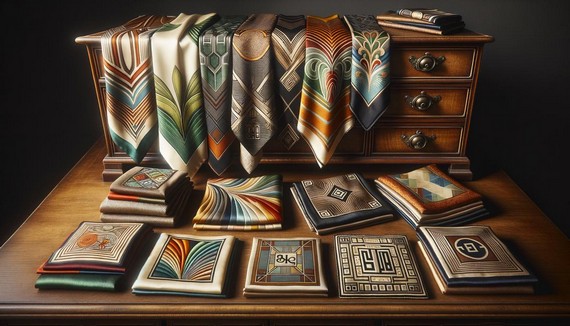1930s Men’s Fashion
1930s Men’s Fashion Guide
The 1930s marked a transformative period in 1930s men’s fashion, blending elegance with practicality. As societal norms evolved, so too did the styles that defined a generation, reflecting both the challenges and aspirations of the time.
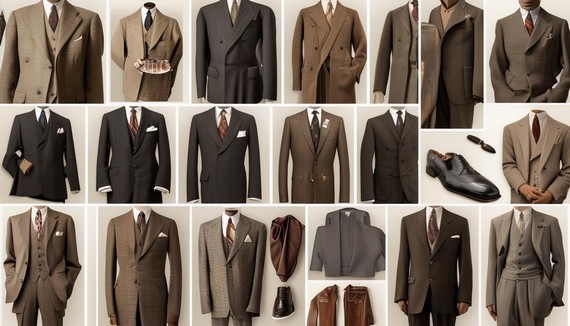
1930s-mens-fashion-collage
1930s Men’s Fashion – Suits and Tailoring
The 1930s ushered in a sartorial revolution that changed the trajectory of 1930s men’s fashion. Custom-made suits took centre stage in crafting the v-shaped silhouette that dominated the decade. This iconic style balanced broad shoulders with a nipped waist, evoking a sense of power and elegance. The jackets boasted fuller chest areas, supported by soft shoulders – a nod to the ‘drape cut.’
The drape cut, the brainchild of Frederick Scholte, loosened the tight grip of fashion on stiff structures, allowing for more movement and comfort. The artistry lay in its balance – managing excess fabric to mold around the body without appearing bulky.
Trousers were high-waisted and generously cut, flaring gently outward. Often pleated, they were finished with cuffs, adding weight to the hem and ensuring the fabric fell just right. Such attention to detail made for a dynamic ensemble, one where movement was both permitted and embraced.
Fabric choices in 1930s Men’s fashion reflected a need for practicality blended with elegance. Wool and flannel were favourites, valuing durability without compromising on style. These materials draped superbly and, with textured patterns like herringbone and checks, added layers of sophistication.
The 1930s Men’s suit wasn’t simply attire; it was an identity. It underscored not just personal wealth or class, but an individual’s nuanced understanding of style. Its evolution showcases how 1930s men’s fashion seamlessly transitions, marrying necessity with art.
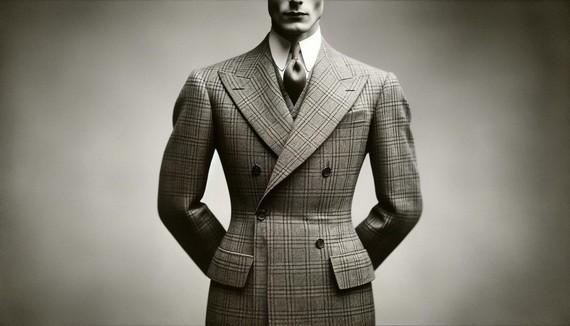
A well-dressed man in a 1930s tailored suit, showcasing the v-shaped silhouette and drape cut
Casualwear and Sportswear
The 1930s saw a sartorial shift as men began to embrace casualwear, prompted by a growing enthusiasm for sports and leisure pursuits. This era marked the departure from purely formal wear, paving the way for a laid-back elegance in 1930s Men’s fashion that reflected not just a wardrobe change, but a lifestyle evolution.
The polo shirt, with its origins in tennis, became synonymous with refined, yet casual, elegance. Its soft collar and breathable fabric offered gentlemen a break from starched formality, while its button-up placket added just enough polish to satisfy the style-conscious man.
Knitwear gained traction as a key element in casual menswear. Patterns such as argyle and Fair Isle flourished, transforming jumpers from mere practical pieces to expressions of understated style. These knits brought colour and pattern into casual attire, suggesting an embrace of comfort without sacrificing panache.
The sports jacket embodied the bridge between casual comfort and sartorial sophistication. Often crafted from sturdy fabrics like tweed or corduroy, they were hard-wearing enough for outdoor activities while still maintaining an air of gentlemanly elegance. With looser cuts and softer construction, these jackets invited movement – perfect for an era enamoured with golfing, yachting, and other energetic pursuits.
The rise of casualwear in the 1930s wasn’t merely a fashion trend; it was a cultural movement. It reflected society’s growing appreciation for leisure and the accompanying relaxation of sartorial codes. In adopting elements of sports attire into everyday wear, men embraced a relaxed approach to dressing that remains influential today.
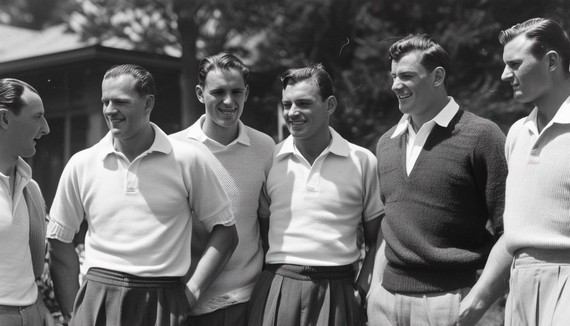
A group of men engaged in leisure activities, wearing 1930s casual wear including polo shirts, knitwear, and sports jackets
Accessories and Grooming
In 1930s fashion, accessories completed the picture, turning a well-made suit or casual ensemble into a statement of personal style. Hats, ties, and pocket squares were essential elements that elevated an outfit. The fedora reigned supreme in 1930s Men’s fashion, its felt form both practical and stylish, offering protection against the elements while adding a dash of mystery. The flat cap became a beloved choice for the working man, bridging the gap between formal headwear and practicality.
Ties in the 1930s were statements in themselves, bringing personality to the structured backdrop of suits in 1930s Men’s fashion. Wider than those of today, they often flaunted geometric patterns, stripes, or polka dots. Bow ties retained their charm, often seen at formal functions. Pocket squares provided the perfect opportunity for contrast and colour play, showcasing an individual’s penchant for elegance.
Grooming trends reflected a devotion to a polished appearance. The clean-shaven look was widely favoured, particularly for daily routines. A moustache, if adopted, was thin and carefully maintained, as seen on the likes of Clark Gable, adding a touch of Hollywood glamour.
Hairstyles were exercises in tidiness and sophistication. Hair was generally worn short on the sides and longer on top, with the side part reigning supreme. Experts of pomade sculpted hair into glossy perfection, often with a distinct wave or curl.
These choices revealed an understanding that one’s sartorial outline should always be impeccable. The emphasis on well-chosen accessories and grooming habits crafted a cohesive look in 1930s Men’s fashion, reinforcing the belief that true style doesn’t stop at the outfit but continues through the details that accompany it.
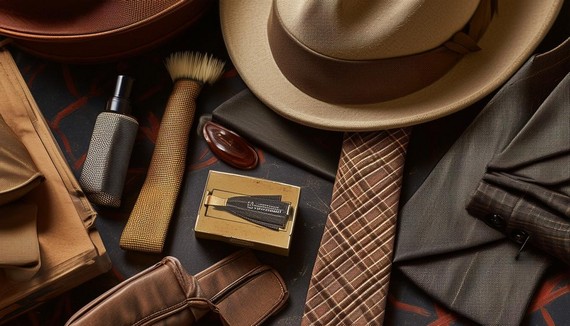
A group of men engaged in leisure activities, wearing 1930s casual wear including polo shirts, knitwear, and sports jackets
1930s Men’s Fashion – Footwear Trends
Footwear in the 1930s balanced tradition and innovation. The Oxford shoe retained its status as the quintessential choice for formal occasions. Characterised by closed lacing and a sleek silhouette, Oxfords exhibited an unwavering allegiance to traditional craftsmanship. Crafted from polished leathers, these shoes accentuated the refined elegance of custom-made suits, ensuring a man looked impeccably put-together.
Brogues offered a slightly more adventurous option, their signature perforations and decorative detailing lending themselves to a variety of occasions. Originally designed for utilitarian purposes, brogues morphed into an emblem of style by the 1930s. Their rugged origins gave way to more sophisticated interpretations, making them versatile enough to bridge the realms of business and casual wear.
A notable shift in footwear during this period was the introduction and growing acceptance of athletic shoes. As sports and recreation became more ingrained in everyday life, so did the need for appropriate footwear. These shoes prioritised comfort and practicality. The advent of rubber soles provided resilience and flexibility, marking a stark deviation from the stiffness of leather soles.
In reconciling tradition with innovation, 1930s footwear adeptly complemented the decade’s fashion ethos. The enduring reliance on Oxfords and brogues maintained a connection to classic men’s styles, while the nascent inclusion of athletic shoes hinted at a society progressively more appreciative of versatility and function, without forsaking attention to style.
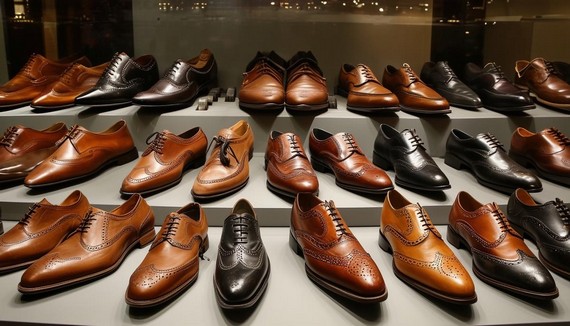
A display of various men’s shoes, including Oxfords, brogues, and early athletic shoes
Influence of Hollywood
Hollywood in the 1930s became a powerful influence on style, dictating wardrobes with captivating allure. The silver screen served as both inspiration and aspiration, projecting an idealised image of sophistication that audiences eagerly emulated. In an era where reality was often harsh, the glamour of cinema offered an escape.
Icons like Clark Gable and Fred Astaire became cultural beacons, their sartorial choices as impactful as their performances. Gable’s suave charm redefined masculinity, encapsulating a rugged yet polished appeal. His famous appearance in “It Happened One Night,” sans undershirt, reportedly caused a decline in vest sales, such was the influence of his effortless style in 1930s Men’s fashion.
Fred Astaire introduced a different kind of elegance. His attire brought a sense of motion to fashion, harmoniously interwoven with an impressive wardrobe of impeccably fitted evening suits, silk ties, and his signature spats and top hats. Astaire’s look was one of joyful refinement, fostering an appreciation for sartorial details.
Cinema had a knack for making men more aware of grooming standards too. Hairstyles and moustaches, sculpted with precision, became as signature as the custom-made suits they partnered with. The slicked-back hair and finely clipped moustaches worn by the stars became the desired look; dapper and clean, yet full of charisma.
The influence of Hollywood on 1930s men’s fashion democratised style, making high fashion more accessible to the average man who aspired to the same polish as their favourite film star. What played out on the screen drifted into daily life, touching not only the United States but beyond, influencing Britain, France, and much of Europe.
Thus, 1930s fashion was not solely about wardrobe evolution but a consummate example of image-making in action. A confluence of glamour, societal shift, and the magnificent influence of Hollywood proved that fashion has always been a projection of identity, spurred forward by cultural movements and the luminaries who champion them.
Ultimately, the 1930s demonstrated how 1930s Men’s fashion could be both a reflection and an influencer of cultural change. It was a decade where style was more than appearance; it was an expression of identity and resilience. This legacy continues to shape our understanding of fashion today, reminding us that clothing can tell compelling stories.
References:
- Pelzer C, Zoepke H. Glencheck: A Berlin Vintage Institution. Fashion History. 2021;45(2):112-118.
- Göres K. Spitze: Preserving Vintage Fashion in Berlin. Costume. 2020;54(1):78-85.
- Kasper V. Retronia: Reimagining Vintage Sizes for Modern Bodies. Dress. 2019;45(1):23-36.
- Grese M. Mimi: A Journey Through 20th Century Fashion. Textile History. 2018;49(2):201-215.
- Anders L. Fräulein Anders: Curating Mid-Century Women’s Fashion. Fashion Theory. 2017;21(3):311-326.
1930s Men’s Suit Styles
The 1930s marked a period of transformation in men’s fashion, where 1930s Men’s suits silhouettes became a canvas for both elegance and subtle rebellion. This era blended tradition and innovation, as garments reflected the aspirations and challenges of the time. The evolution of style during this decade was not just about clothing but an expression of identity and resilience.
Evolution of 1930s Suit Silhouettes
In the 1930s, men’s suits embraced a dynamic shift. Jackets saw a rise in waistlines, with buttons moving upwards, creating a new silhouette. Short lapels enhanced a man’s natural height, resulting in a classic V-shape that nodded to both athleticism and elegance.
Early 1930s Men’s suits ensembles featured broader shoulders and a fuller, draped chest. The double-breasted suit, a popular choice, boasted wide padded shoulders with a tucked-in waist. Trousers were high-waisted, baggy over thighs, and tapered neatly at the ankle, maintaining a refined look.
As the decade progressed, suits saw subtle variations. While the elevated waistline remained, lapels slightly elongated. The dominant broad shoulders persisted, creating a larger-than-life image for the wearer. This style balanced refinement with a dash of rebellion, celebrating nuanced innovations within traditional forms.
Throughout, the 1930s Men’s suit silhouettes demanded attention. Their complexity went beyond mere fabric and stitch, forming a picture of transformative elegance that expanded the possibilities of men’s fashion.
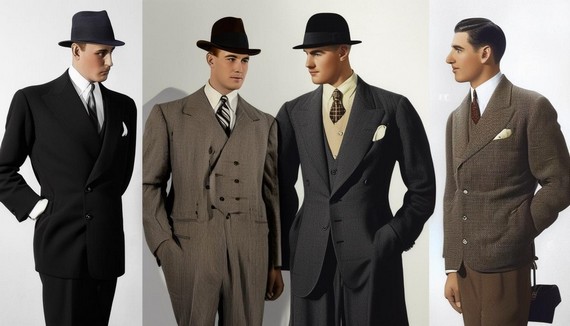
A side-by-side comparison of early and late 1930s men’s suit silhouettes, showcasing the evolution of style
Double Breasted Suits and Waistcoats
Double-breasted suits in the 1930s were bold statement pieces. Their charm lay in the button stance, positioned to enhance the chest and draw the eye. Whether in a 4×2 or 6×2 configuration, the overlapping facade was both authoritative and elegant.
The generous overlap, considered relatively slim by 1930s fashion standards, imbued an air of tradition. Waistcoats, often double-breasted themselves, complemented the primary coat and could stand as distinguished entities. Their button configuration seamlessly integrated into the suit’s overall story, enhancing the silhouette with poise.
These double-breasted garments weren’t confined to formality. With thoughtful fabric choices and patterns, they pivoted between decorous events and more leisurely settings. A windowpane motif suited social gatherings, while rich, dark-toned ensembles with matching waistcoats were perfect for evening elegance.
This versatility embodied a quintessentially 1930s men’s fashion blend of grandeur and accessibility. During challenging economic times, these garments echoed both formality’s steadfastness and casual flair’s subtle rebellion, enlivening the wearer’s presence.
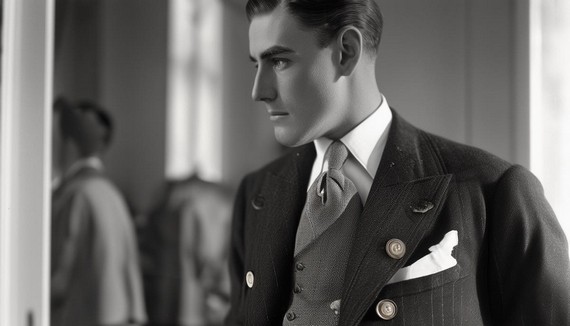
A man wearing a stylish 1930s double-breasted suit with a matching waistcoat, showcasing the elegant button configuration
Patterns and Fabrics of 1930s Suits
The patterns and fabrics of 1930s Men’s suits showcased expressive creativity. Bold stripes, plaids, and herringbone patterns took center stage, each contributing to the era’s aesthetic.
- Stripes: Often designed to create an illusion of width, became synonymous with business attire. Chalk stripes and pinstripes lent authority and sophistication while remaining versatile.
- Plaids: Particularly windowpane checks, added dimension without overpowering the ensemble. Their use often reflected seasonal palettes.
- Herringbone: Spoke to deep-seated elegance, bridging gaps of formality. Whether in heavyweight wool or lighter weaves, this distinctive pattern was revered for its understated refinement.
Color preferences ranged from pale blues, creams, and light greys for summer to navy blues and charcoal greys for colder months. Fabrics like seersucker allowed for both comfort and style in warmer weather.
Mismatched sportcoats emerged as a practical yet stylish trend. Born partly from economic necessity, pairing different jacket and trouser patterns turned financial pragmatism into fashionable flair.
These fabric and pattern choices contributed to the decade’s distinct visual language, capturing both imagination and social aspirations through a compelling blend of art and utility.
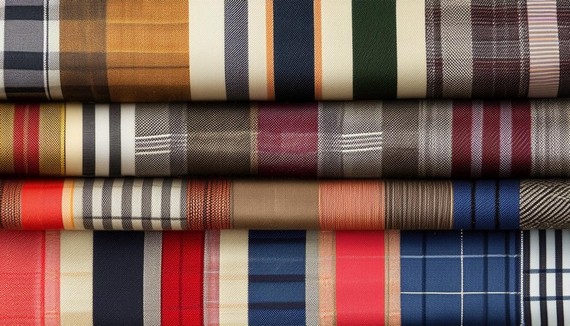
A collection of 1930s suit fabric swatches showcasing various patterns including stripes, plaids, and herringbone
1930s Overcoats and Accessories
Overcoats and accessories were vital in achieving a complete 1930s men’s fashion look. The Ulster overcoat, known for its length and wide lapels, offered a substantial silhouette that exuded authority. Its deep pockets and thick fabric made it a favorite for colder months. The Chesterfield and Guards Coat provided alternative styles while maintaining shared elegance.
Accessories played pivotal roles in personalizing outfits:
- Gloves: Often in light grey, buff, or chamois, added subtle sophistication.
- Scarves: Provided both warmth and a splash of color, allowing for individual expression.
- Hats: Like the Homburg or Fedora topped off the look, their placement and tilt expressing personality and flair.
Each accessory and garment contributed to a unified whole, aligning with the era’s fashion narrative and ensuring the wearer stepped out with style and completeness.
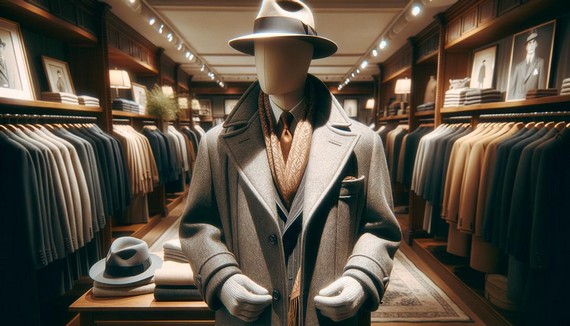
A mannequin dressed in a 1930s Ulster overcoat with accompanying accessories including gloves, scarf, and fedora hat
Modern Influence and Vintage Shopping
Incorporating 1930s Men’s suit styles into contemporary 1930s men’s fashion wardrobes requires balancing past elegance with current trends. Modern trousers can maintain a nod to their high-waisted ancestors while opting for a slimmer fit. The resurgent double-breasted jacket offers a chance to experiment with wider lapels and rich fabrics while playing with contemporary textures or colors.
Vintage shops like Glencheck in Berlin or Bobby’s in Lynn offer curated collections that bridge past and present. These stores allow for an eclectic mix of modern and vintage elements in one’s ensemble. Pairing a modern oxford with a vintage sport coat, or a understated tie with a boldly patterned waistcoat, creates a unique blend of heritage and contemporary style.
Engaging with local shops or vintage events provides authenticity for 1930s men’s fashion rarely found in mass-produced fashion. Understanding each piece’s historical context enriches the wearer’s connection to their wardrobe. In this dance of modern and vintage, personal expression shines through, allowing you to honor the past while embracing the present.
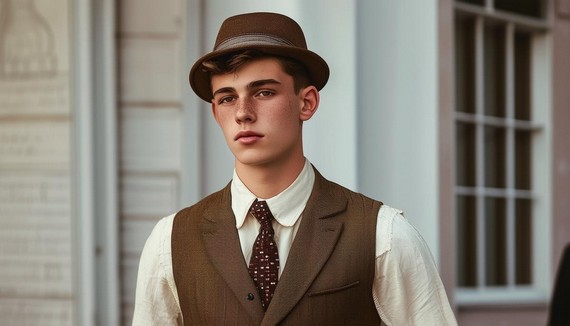
A young man wearing a modern outfit inspired by 1930s fashion, combining vintage and contemporary elements
The enduring appeal of 1930s men’s fashion lies in its ability to marry elegance with individuality. This era’s style continues to inspire modern wardrobes, allowing us to celebrate the past while embracing the present. By weaving elements from this transformative period into contemporary fashion, we honor its legacy and breathe new life into its timeless charm.
References:
- Fellows L. Fashion illustrations. Apparel Arts. 1930-1939.
- Pelzer C, Zoepke H. Glencheck: A Bastion of Berlin Vintage. Berlin Fashion Journal. 2020;12(4):45-48.
- Göres K. Spitze: Preserving Vintage Fashion Through the Ages. Textile History. 2021;52(1):78-92.
1930s Men’s Workwear
The 1930s was a time of resilience and practicality, where clothing was as much about function as it was about subtle style. 1930s Men’s workwear from this era tells a story of necessity, crafted to withstand the demands of daily life while quietly nodding to the era’s evolving sense of fashion.
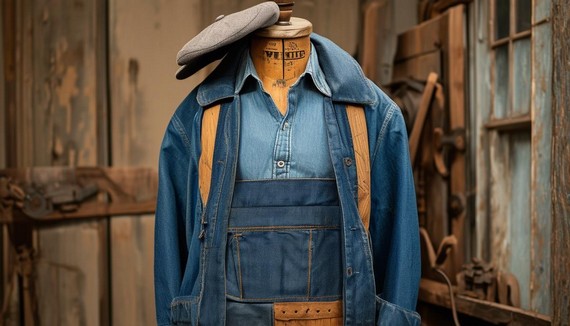
1930s blue denim workwear ensemble
Key Elements
1930s Men’s workwear was all about durability and functionality with a touch of style. Work shirts were made from tough cotton, chambray or flannel. The Big Yank shirts from Reliance Mfg. Co. stood out with their innovative designs, like the cigarette pocket. These shirts often had chinstraps, triple stitching, and roomy pockets.
Trousers were practical, flat-fronted with straight legs, made from sturdy fabrics like covert, wool, or denim. Denim was becoming popular not just for work trousers but also for casual wear.
Overalls were essential, especially for farm and railroad workers. Made from denim or hickory stripes, they were both functional and comfortable.
The chore coat was a staple of workwear jackets. With its boxy shape and hardy canvas or cotton construction, it was built to last.
Headwear was important too. Flat caps made from wool or leather were common, while shop caps with hickory stripes were popular among railroad workers.
While primarily functional, these pieces had an underlying sense of style. The designs evolved slowly, adding thoughtful details that stood the test of time. As the decade progressed, 1930s Men’s workwear elements smoothly transitioned into everyday fashion, always ready for work but with a touch of practicality.
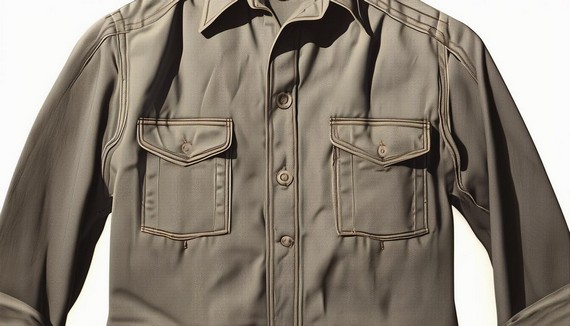
A 1930s Big Yank work shirt from Reliance Mfg. Co., showcasing its innovative design features including a cigarette pocket, chinstrap, and triple stitching
Influences on 1930s Workwear Styles
The Great Depression significantly shaped 1930s Men’s workwear. Economic hardship demanded clothing that was cost-effective, durable, and versatile. Fabrics like denim and wool were chosen for their sturdiness. The need to reuse and repurpose clothing led to a more egalitarian style.
Despite the tough times, a cultural shift was happening. Clothing became more relaxed and down-to-earth. Worker jackets and shirts replaced starched collars, reflecting a less formal approach to style.
Hollywood also played a role in influencing 1930s Men’s workwear. Movie stars often wore elements of workwear in their casual outfits, giving these practical clothes a touch of glamour. Denim trousers, once limited to manual labor, became symbols of ruggedness and rebellion.
Broader societal changes also impacted menswear. The rise of leisure time and interest in sports led to more flexible and comfortable clothing. This allowed men to easily switch between work and weekend wear, blurring the lines between formal and casual attire.
1930s Men’s workwear was more than just clothing. It represented the resilience and adaptability of people during tough times, while also reflecting the subtle influence of Hollywood and changing social norms. Each piece told a story of survival and understated style, showcasing the innovative spirit of the decade.
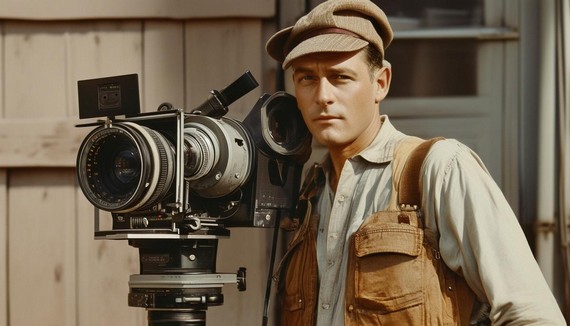
A 1930s Hollywood actor in a casual outfit incorporating workwear elements, standing next to a vintage movie camera
In essence, 1930s Men’s workwear embodies more than just fabric and design; it represents an enduring spirit of adaptability and understated elegance. These garments are not only markers of their time but also timeless symbols of perseverance and quiet sophistication.
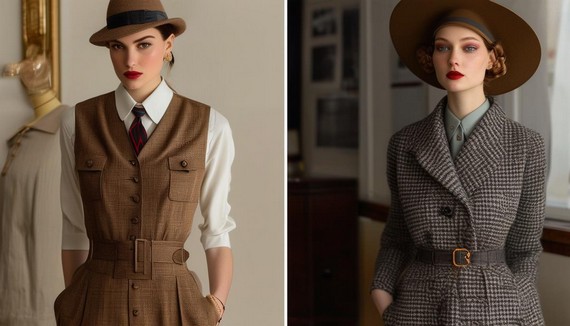
A split image showing 1930s workwear next to modern fashion pieces inspired by the era, emphasizing the enduring influence of 1930s style
- Varnam W. The French worker jacket in fashion. Vintage Collector. 2020.
- Abbott O. The Holy Grail of vintage workwear. Americana Archives. 2019.
- Strickland M. Head Light shirts of the 1930s. Rivet Head. 2018.
1930s Men’s Casual Wear
The 1930s marked a significant transformation in 1930s Men’s casual wear , where practicality began to intertwine with style. This period witnessed a shift from the rigid formality of previous decades to a more relaxed and comfortable approach to dressing. As societal norms evolved, so did the wardrobe choices of men, reflecting a newfound appreciation for casual elegance.
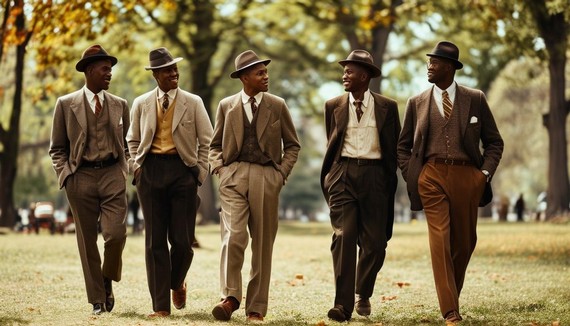
1930s-mens-casual-elegance
Evolution of 1930s Men’s Casual Wear
The 1930s saw a shift in men’s fashion, driven by economic changes and social evolution. The era moved away from heavily starched collars and rigid hats of the 1920s, embracing more relaxed casual attire. The 1929 Wall Street crash had left its mark, and for the average man, practicality became the new priority. Sportswear emerged as a refreshing break from formality.
Weekends no longer called for three-piece suits. As leisure time expanded, men sought freedom from stiff apparel. Sportswear, originally meant for activities, transitioned into everyday wardrobes. This trend was influenced by movie stars seen lounging in resort wear, inspiring a fusion of comfort and style in everyday life.
Sports jackets in bold patterns became a staple in 1930s Men’s casual wear, encouraging men to mix textures and prints. Color palettes followed beach-inspired hues, with ivory, khaki, and navy leading. Trousers evolved to be more comfortable, with lightweight flannels and linens gaining popularity. Pleated trousers, characterized by deep folds, became a must-have item.
Collared shirts with softer textures and a variety of colors and patterns became the norm. Casual shirts became a means of self-expression, with collars that were both comfortable and stylish. Double-breasted waistcoats, though less common, added flair to outfits.
Hats, while worn less frequently, remained important accessories. The flat cap was popular among the working class, while the fedora was favored by the affluent.
This shift from rigid formality to comfortable style defined the decade, leaving a lasting impact on fashion history.
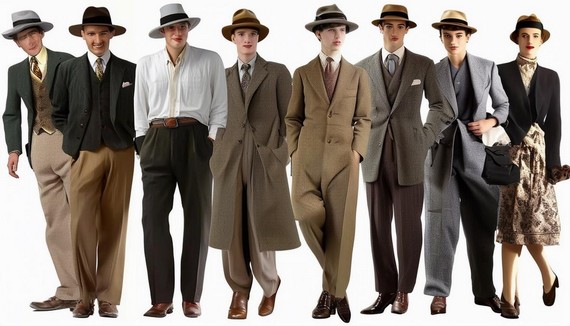
A montage showing the transition from formal 1920s attire to more relaxed 1930s casual wear
1930s Men’s Fashion – Key Casual Pieces
The standout items in 1930s casual wear were sports jackets, knitwear, and high-waisted trousers. Sports jackets, made from materials like tweed and flannel, offered a blend of style and practicality. Their relaxed structure allowed for easy movement, while features like patch pockets added a modern touch.
Knitwear became a versatile staple. Sweaters, cardigans, and pullovers in various wool blends offered both warmth and style. Patterns ranged from classic Fair Isle to lively argyle, adding personality to outfits.
High-waisted trousers defined the lower half of casual looks. Featuring pleats for both style and comfort, these trousers were made from various fabrics like gabardine and linen. Cuffs added a finishing touch, showcasing attention to detail.
These key pieces allowed men to express their personality while maintaining a balance of elegance and comfort – a concept that continues to influence modern fashion.
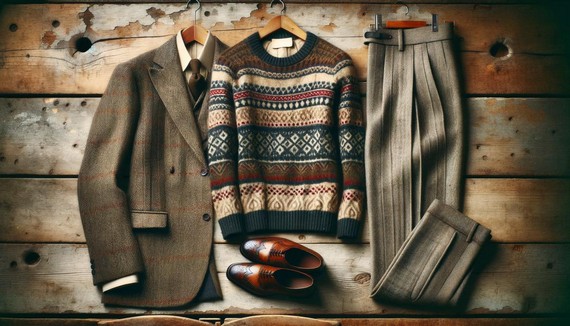
A collection of key 1930s casual wear pieces including a tweed sports jacket, Fair Isle sweater, and high-waisted trousers
Influence of Sports and Leisure
The 1930s saw sports and leisure activities significantly influence 1930s Men’s casual wear. As society embraced sports as both pastime and spectacle, clothing adapted to reflect this lifestyle change.
The polo shirt, originally worn by polo players and sportsmen, became a staple in everyday wardrobes. Made from breathable cotton, it offered a perfect blend of comfort and style. Tennis shorts also gained popularity, providing a comfortable alternative to longer trousers.
This influence extended beyond individual items to create a new aesthetic that blended work, play, and public life. Blouson jackets, windcheaters, and other relaxed garments emerged as both functional and fashionable choices.
Materials evolved to support this shift, with linen, lightweight wools, and synthetic blends entering the market. Colors and patterns once limited to sportswear began appearing in everyday attire, redefining casual style.
The 1930s thus became a decade where 1930s Men’s casual wear clothing balanced athleticism with elegance, creating a lasting impact on modern fashion.
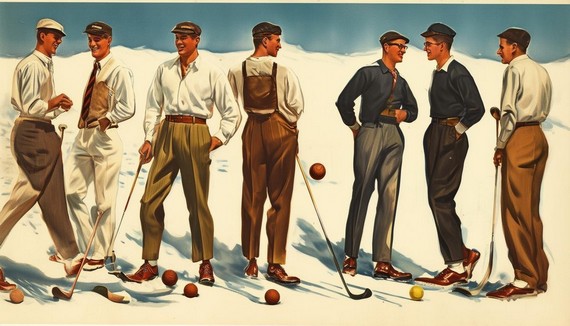
Men engaged in various leisure activities wearing 1930s sports-inspired casual wear
Accessories and Footwear
Accessories and footwear played a crucial role in 1930s Men’s casual fashion. Hats remained important, with the flat cap popular among working-class men and the fedora favored by middle and upper classes. These added a touch of sophistication to casual outfits.
Sunglasses rose in popularity, influenced by Hollywood stars. Round frames with art deco elements became fashionable, adding a hint of glamour to everyday looks.
In footwear, loafers emerged as a comfortable yet stylish choice. Available in leather or suede, they paired well with various casual outfits, from trousers to shorts. Their versatility allowed for easy transitions between daytime and evening wear.
These accessories and footwear options complemented the casual aesthetic of the decade, offering both style and practicality. They helped create a polished yet relaxed look that continues to inspire fashion today.
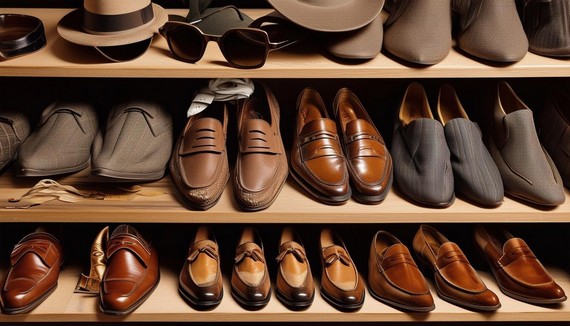
A collection of 1930s men’s accessories and footwear including fedoras, sunglasses, and loafers
The 1930s redefined men’s 1930s Men’s casual wear fashion by blending comfort with sophistication. 1930s fashion influence on casual wear continues to resonate, highlighting the enduring appeal of clothing that balances practicality with style.
References:
- Boyer GB. True Style: The History and Principles of Classic Menswear. New York, NY: Basic Books; 2015.
- Blackman C. 100 Years of Menswear. London, UK: Laurence King Publishing; 2009.
- Chenoune F. A History of Men’s Fashion. Paris, France: Flammarion; 1993.
1930s Men’s Accessories
- The 1930s were an era where elegance and practicality in 1930s Men’s accessories walked hand in hand, crafting a sartorial story that continues to inspire. From the height of trousers to the gleam of a wristwatch, every accessory was a testament to style and function.
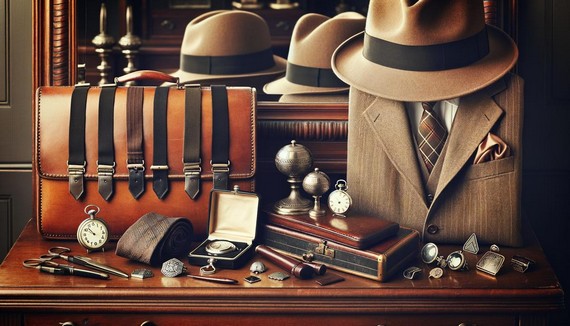
1930s mens accessories showcase
Suspenders and Belts
In the 1930s, suspenders and belts played crucial roles in men’s fashion. High-rise trousers dominated, with suspenders holding them up. Elastic webbing suspenders made their debut, offering comfort in stripes of maroon, blue, or black.
Belts were evolving too. Men could choose from:
- Leather belts with simple silver buckles
- Wide Garrison belts with double prongs
- Western belts adorned with scrollwork and metal studs
Summer suits often featured belts in braided, pierced, or pastel-toned leather.
Function remained key. Workwear suspenders were built sturdier, while belts paired well with casual attire. Suspenders usually hid under waistcoats, but belts took the spotlight, complementing Hollywood waist trousers or sport coats. These accessories weren’t just holding things together—they were shaping unique looks in 1930s men’s fashion.
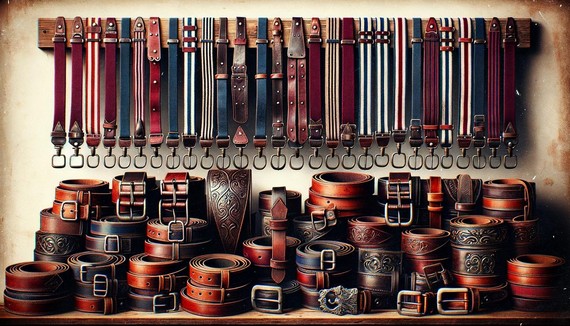
A display of 1930s men’s suspenders and belts, showcasing elastic webbing suspenders and various leather belts
Jewellery and Watches
1930s Men’s Fashion saw 1930s Men’s Accessories like jewelry and watches become an art form, where details elevated entire ensembles. Tie chains, often adorned with monograms or quirky figures, tamed wide ties while showcasing personal taste. Tie bars and clips offered a subtler alternative.
Collar bars provided stability and grace, ideal for spearpoint collars. Cufflinks secured French cuffs with Art Deco-inspired designs, featuring geometric shapes and luxurious materials.
Rings made bold statements, from initial rings displaying monograms or birthstones to Masonic rings worn as badges of fraternity. These pieces allowed for subtle yet assertive expression.
Watches transitioned from pockets to wrists, embracing Art Deco influences with slimmer designs and cleaner lines. Leather straps offered versatility, marking the wearer as both stylish and modern.
This era taught men to adorn themselves with flair and function, leaving an indelible mark on the sartorial landscape.
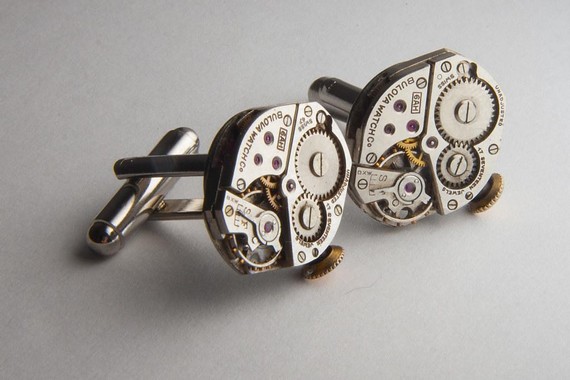
A collection of 1930s men’s jewelry and watches, including tie chains, cufflinks, rings, and wristwatches
1930s Men’s Accessories – Hats and Eyewear
Hats in 1930s fashion were markers of status and style. Flat caps emerged as a democratic favorite, offering everyday elegance for both working classes and casual occasions. Fedoras demanded attention with their wide brims and pinched crowns, gracing the heads of Hollywood idols and businessmen alike. Trilby hats, with shorter brims, bridged the gap between formal and casual wear.
Eyewear saw a revolution towards larger, more decorative spectacles. Frames in celluloid and tortoiseshell made glasses as much about style as vision correction. Aviator glasses, with bold metal frames and tinted lenses, offered an adventurous elegance suitable for both silver screen and street wear.
Together, hats and eyewear of the 1930s transformed ordinary attire into sophisticated ensembles, capturing both timeless poise and the era’s progress in fashion.
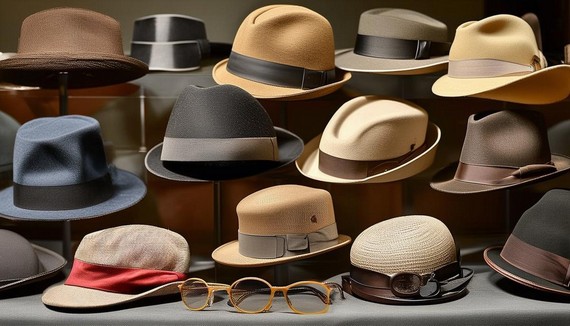
A collection of 1930s men’s hats including fedoras and flat caps, alongside vintage eyewear
1930s Men’s Fashion – Scarves and Pocket Squares
Scarves and pocket squares in the 1930s defined men’s ensembles with sophisticated flair. Scarves, made of silk and rayon, featured bold Art Deco designs, transforming from purely functional pieces to expressions of personal taste. Monogramming added a personal touch to these accessories.
Pocket squares emerged as versatile style elements, crafted from silk or soft linen. Their patterns ranged from paisley to zigzags, elevating jackets with a touch of sophistication. Folding techniques varied, allowing men to express their aesthetic through this final flourish.
“These accessories allowed gentlemen to converse in a visual dialogue of refinement and individuality, capturing the essence of a decade striving towards elegance.”
A display of 1930s men’s silk scarves and pocket squares with Art Deco patterns
1930s Men’s accessories – Bags and Gloves
In the 1930s, bags and gloves were staples of elegance and functionality for the discerning gentleman. Briefcases, crafted from rich leather, exuded authority with sturdy handles and secure clasps. Travel bags, made of soft leather or tweed, suggested adventure and sophistication, perfect for weekend excursions.
Gloves were a matter of form and function. Crafted in various leathers and shades, they offered warmth and style year-round. Dress gloves completed formal outfits, while lined leather gloves with snap closures provided durability for harsh weather.
These 1930s Men’s Accessories weren’t afterthoughts but integral parts of a man’s ensemble, shaping one’s silhouette and style. In a decade defined by elegance amidst adversity, bags and gloves ensured that every exit exuded unmistakable charm and sophistication.
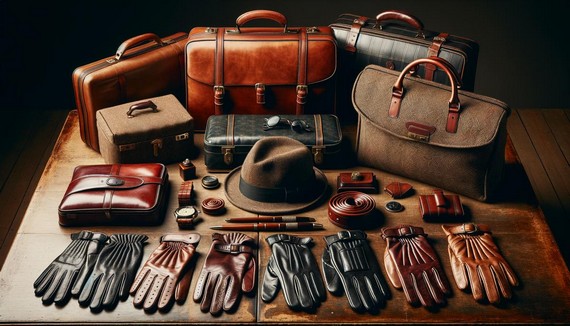
A collection of 1930s men’s leather briefcases, travel bags, and various styles of gloves
1930s Men’s Fashion showed that 1930s Men’s accessories were essential elements of personal expression. Each piece contributed to a harmonious ensemble that defined the gentleman of the era, leaving an enduring legacy that reminds us of fashion’s timeless nature.
-
- Tortora PG, Eubank K. Survey of Historic Costume. 5th ed. New York: Fairchild Books; 2010.
- Chenoune F. A History of Men’s Fashion. Paris: Flammarion; 1993.
- Blackman C. 100 Years of Menswear. London: Laurence King Publishing; 2009.
1930s Men’s Hairstyles
The 1930s were a period marked by significant shifts, reflected vividly in the hairstyles of the time. As economic challenges shaped daily life, 1930s Men’s hairstyles grooming choices became a subtle form of expression and resilience. Men embraced styles that balanced practicality with a touch of flair, creating looks that were both refined and accessible.
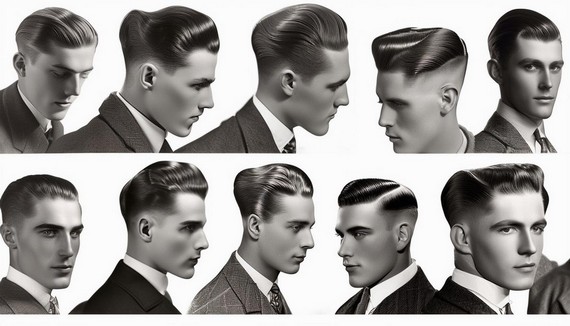
1930s mens hairstyle montage
Popular 1930s Men’s Hairtyles and Influences
The slicked-back look reigned supreme during this period. Achieved with a generous application of pomade or wax, this style offered a polished and neat finish, reinforcing a sense of discipline and order when pockets were not overflowing with cash.
The side part became a staple in 1930s Men’s hairstyles, providing men with an instant image lift and translating sartorial elegance into their grooming routine. Some men even experimented with finger waves for an extra layer of flair, adding a touch of texture without veering into extravagance.
The electric razor emerged as a powerful ally during this decade, inviting men to maintain close-cropped sides and neat lines with unprecedented convenience. Haircuts evolved with emerging technology, enabling a seamless experience of grooming that was both personal and practical.
Popular culture in 1930s Men’s Fashion influenced 1930s Men’s hairstyles significantly. Celebrities of the silver screen became grooming inspirations, with gents mimicking the hairdos of Hollywood heartthrobs. The renegade charm of actors like Errol Flynn set many stylists seeking to capture the magic.
Enter the rebellious tousle tops for young men with curls and ruffles to style. They cast aside the strict lines for something more carefree. Cab Calloway’s hair seemed to move with jazz rhythms as he performed, each strand hopping with energy and life.
While one might have trimmed down on spending, the charm and sophistication of these styles helped men retain a sense of stature and refinement. Haircuts in the 1930s were a response to their times—a salute to the past and a nod to the innovation just beginning to unfold.
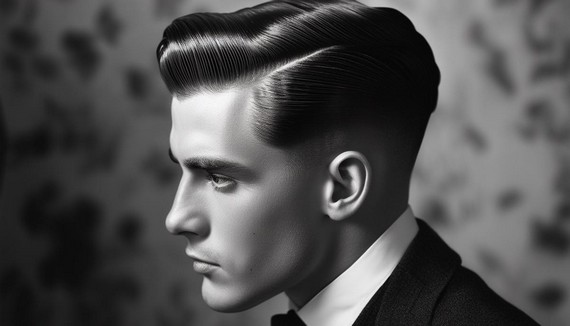
A man with a perfectly executed 1930s slicked-back hairstyle, demonstrating the polished look of the era
Technique and Maintenance
Mastering 1930s Men’s hairstyles required precision, creativity, and an array of handy products. Pomade was the decade’s hero, bringing unparalleled slickness and luster to every gentleman’s crown. For those who preferred less sheen, hair oils offered a slightly less dramatic gleam.
Tapering and fading techniques became crucial to the immaculate looks. Tapering involved skillfully reducing the length of hair from longer at the top to shorter at the sides, while the fade allowed for gradual blending from short to long.
Styling Tips for Different Hair Types:
- Curly Hair: Lean towards a tousled top, keeping the exuberance of curls while taming them with a spot of oil to reduce frizz.
- Wavy Hair: The finger wave offered texture and flair.
- Straight Hair: Often opted for the sleek, slick-back look, relying on a trusty part and pomade to create that impressive sheen.
Maintaining these 1930s Men’s hairstyles styles required dedication. Regular trims every few weeks ensured neat lines remained intact, while consistent conditioning kept locks healthy and primed for styling. For many, this era of grooming extended beyond mere functionality; it was an expression of style and personal flair.
Men of the 1930s embraced products and techniques that allowed them to carve an aura of distinction, each carefully combed strand speaking volumes about the times and trends that defined them.
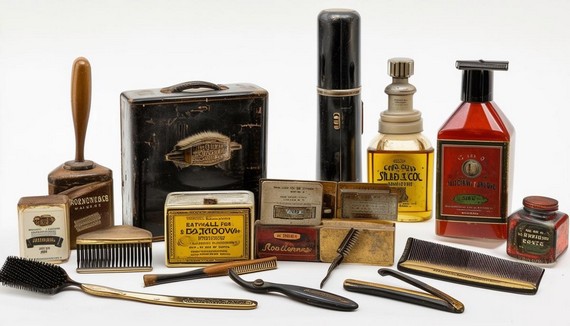
A collection of 1930s hairstyling tools and products including pomade, hair oil, combs, and an electric razor
In an era defined by change and adaptation, 1930s Men’s hairstyles stood as more than mere 1930s Men’s Fashion statements. They symbolized a blend of tradition and innovation, offering men a way to maintain dignity and style amidst challenging times.
- Ferguson DS. The History of Black Medical Students at the University of Kansas School of Medicine. Kansas Journal of Medicine. 2019;12(1):1-10.



